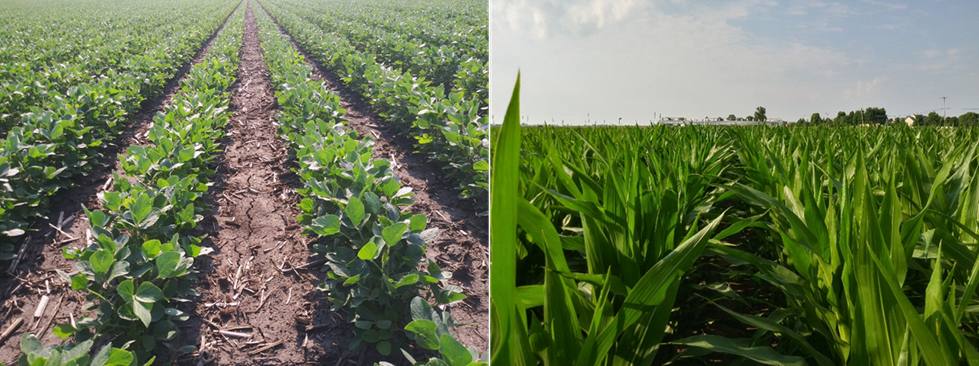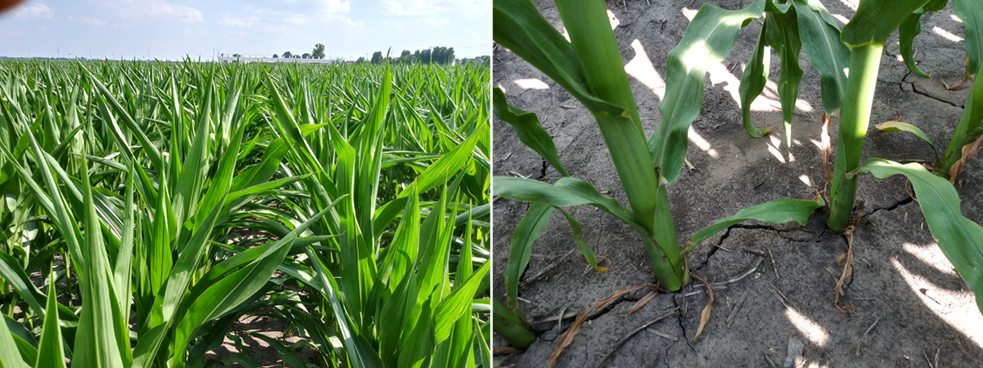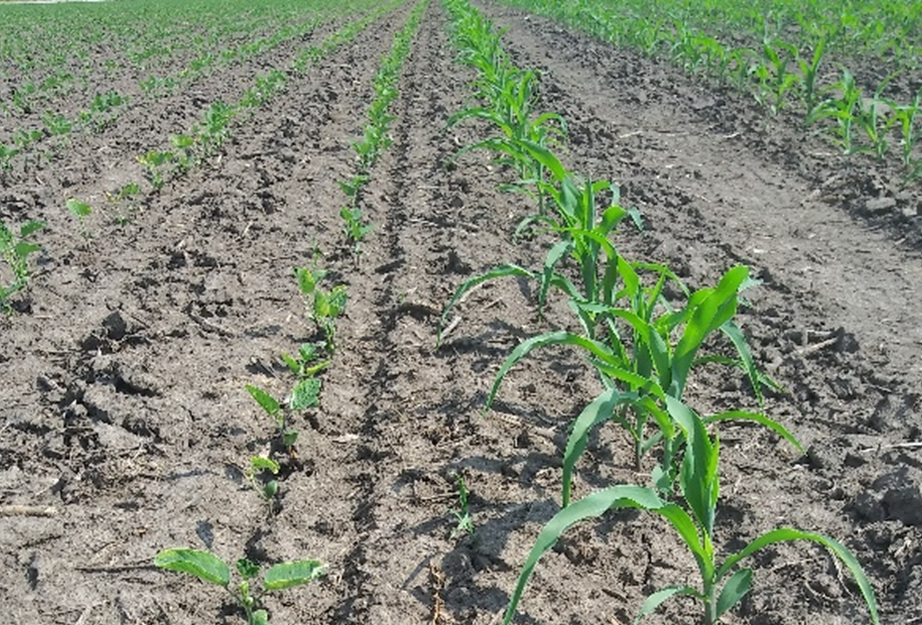Stress and the 2024 corn and soybean crops
As high temperatures continue and rainfall remains scarce, many Illinois producers are getting concerned about prospects for the 2024 crops. While it is not very productive to ask ourselves if we should have managed tillage and planting differently, remembering how this year’s crop is faring might inform some of our decisions in the future.
After a planting season that stretched from late March to mid-June and included a substantial amount of replanting, Illinois corn and soybeans are almost completely planted; even doublecrop soybean planting is beginning to wrap up after an early wheat harvest. Stands are generally good, in some cases after replanting. Crop condition has dropped some, but is much higher than it was at this time in 2023, before rains turned things around and yields ended up high.
Early-planted crops
While we said in our last Crop Central article that 2024 may be a year in which early planting favored corn more than soybean, that depends on what happens weatherwise over the next two months. The photos in Figure 1 are from the same fields shown in that article, taken 16 days later, on June 20. Only an inch of rain has fallen since the first photos, and with high temperatures, almost 400 growing degree days have accumulated over those 16 days. The corn has accumulated almost 1,100 GDD since planting, which should have it at about V15. That’s it’s only at V11 means that stems have elongated more slowly than normal, probably due to less available water. Rainfall will quickly restore rapid stem elongation in such fields, but plants may end up shorter than normal.

The rate of GDD accumulation over the past 10 days has been unusually high; as an example, 92 GDD accumulated at Champaign over the past three days (June 17-19). This does not come from high daytime temperatures—which have been in the 90s—because the high temperature cutoff is 86°, meaning that any temperature above 86 is treated as 86 to calculate GDD). So getting to 30 GDD for a day with high temperatures above 86 means that the lowest night temperature was 74: (86+74)/2 – 50 = 30. The accumulation of 200 GDD in a week is occasionally seen in July, but seldom in June. It is commonly thought that high night temperatures lower crop growth rates. That may be the case, but we do not think that would be enough to lower corn yield potential at this point in the season.
The soybean crop has reached stage V8-R2, with 8 expanded trifoliolate leaves and flowers at most developed nodes. These plants have a little less leaf area than if they had had a more plentiful water supply, but there is no indication that node and pod numbers have been compromised.
Figure 2 shows the same corn as shown in Figure 1, with photos taken on the same day (June 20) but at 4 PM, with temperature at 95°. The crop is clearly under some stress, and even though the leaves in the morning looked healthy, visible stress that continues means decreasing soil water, lower photosynthesis, and some additional loss of leaf integrity. Lower stem diameter is normal, but there is little brace root development. Lower leaves also have an unusual, and unhealthy-looking, color (Figure 2). It is not clear that these will revive to become productive even if rains returns. If upper leaf expansion is limited as well, canopies may remain incomplete and kernel numbers and grainfilling rates may be lower as a result.

While the development of drought stress symptoms during the day is not welcome, it has rarely translated into serious yield loss, providing that rain returns before growth (height increase) appears to stop. Having good leaf color in the morning indicates that plants have root systems established well enough to take up N, and also that the plant has moved a fair amount of water out of the soil into the air; more transpiration means more photosynthesis. If water is plentiful and temperatures are warm, corn may take up about 6-7 inches of water, or a third of its seasonal water, by the time it reaches V12-13. More than 10 inches of rain fell on this field since planting, with some of that running off the higher part of the field where the photo was taken. So we think there is enough water in the soil to maintain the crop’s yield potential for a week or two still, but that will come at the expense of lower daily productivity as leaves curl earlier as soils dry out.
Unlike corn, soybeans showed little effect of dryness in late afternoon on June 20, so no photo of those is included. We know from experience, including in 2023, that node number and leaf area can increase very rapidly once rain falls.
Late-planted crops
Figure 3 shows soybean and corn in a field on South Farm in which wet soils delayed planted until June 4. Soil moisture was good at planting, and about an inch of rain fell within a week of planting; it has been dry since then. Corn emerged well and appears to be growing well, with little afternoon leaf curling leaf. Almost 400 GDD accumulated from planting to June 20, bringing the crop to stage V4. Soybeans are in 15-inch rows with about 3 inches between dropped seeds, but show lower populations than normal, and a lot of unevenness in growth. They emerged beginning about the same time corn emerged (5 days after planting), are at stages ranging from VE to V2, with some plants that seem to have stopped growing. It is not certain what caused this, but damage from herbicide (Authority Supreme applied 3 days after planting) might be a possibility. It rained about a half inch after planting and temperatures were normal for a week, then rose to highs in the 90s after that.

Despite rapid emergence and mostly good growth crop appearance of crops planted very, these crops are capturing no more than single-digit percentages of sunlight falling on the field on the longest days of the year. While less stress is a good thing, having so much of their growth and yield potential still to develop represents some risk to yield in late-planted fields. About 2,130 GDDs normally accumulate between June 21 and September 30 in east-central Illinois, so if temperatures return to normal, the crop shown in Figure 3 will accumulate about 2,520 GDD by the end of September. That’s about 200 GDD less than medium-maturity corn hybrids need to reach maturity, although late-planted corn may need fewer GDD than a hybrid is rated for. If that happens—if late-planted corn requires fewer GDDs to maturity—then it is likely that it will yield less as well.
Soil issues
In areas where it was wet and planting was delayed, tilling and planting into wet soils produced a number of problems, including soil compaction, sidewall “compaction” (or smearing), corn with restricted nodal root development, and related plant problems. These are not uncommon in fields, but show up as potential yield-limiting problems mostly when rains stop, especially if rains stop and it turns hot. Some examples:
- As we saw in 2023, dust blew off of soils in high winds in May, especially in fields that had been tilled, then got wet, then dried off, leaving a layer of fine soil particles on the surface. The more cover fields had, the less problem with dust: no-till, strip-till, and fields with cover crop residue lost less soil this way. Heavy rainfall also moved soil down slopes, especially where soil was without cover.
- This was a spring where soil not tilled last fall tended to be ready to plant a little sooner, probably due to better capillarity—the ability of water to move among connected soil particles to the surface as it evaporates. This does not mean we should stop tilling, but some might want to reconsider practices like fall-tilling soybean residue, which leaves little cover and can, in some springs, mean a little slower drying.
- Ponds formed in many fields after planting, and where water stood for a few days, seeds and seedlings were more likely to survive if it was cool than if it was warm. A great deal of “fill-in” planting was done in corn fields, some of which survived. Inadequate stands in many soybean fields were supplemented with more seed. Where submergence was followed by emergence, plants came back better if there was a longer dry period that allowed soil to dry out. With the chance to grow roots into drying soil, plants in these low areas may have decent yield potential as long as rains return but water doesn’t stand again.
- As is usually the case, soil compaction from tillage or planting equipment is widespread. Compacted areas are showing stress symptoms earlier on hot days, and such plants may remain undersized with smaller leaves. Rain will help in these areas, if water doesn’t stand and if soils don’t dry enough to stress plants again. Low areas that held water may well have experienced denitrification, which could leave the crop short of N if growth resumes after rain falls. If rain does not return and growth rates do not rebound before pollination, applying more N will probably not increase yield.
- In some fields that were planted without tillage into wet soil conditions, walls of the planting furrow are drying out. Plants may be sitting in the furrow supported by their seminal root system, but without the ability to form and send nodal roots into the bulk soil. The prospects for such plants aren’t very positive, but as long as such “rootless” plants don’t flop over and break free from their attachment to the soil, rainfall will bring them back quickly. Depending on when that happens, such plants may not have enough time to develop good yield potential.
Although late planting is something we’d prefer never to see, we know that today’s corn hybrids and soybean varieties have remarkable ability to come back from stress effects in the first half of the season to yield well. There is no indication that we need to apply more and different inputs than we normally would in order to enable such recovery. With crop insurance there to prevent catastrophic loss in case stress continues through the rest of the season, we can proceed with normal attention to the crop through the rest of the season, and deal with issues as they arise.





